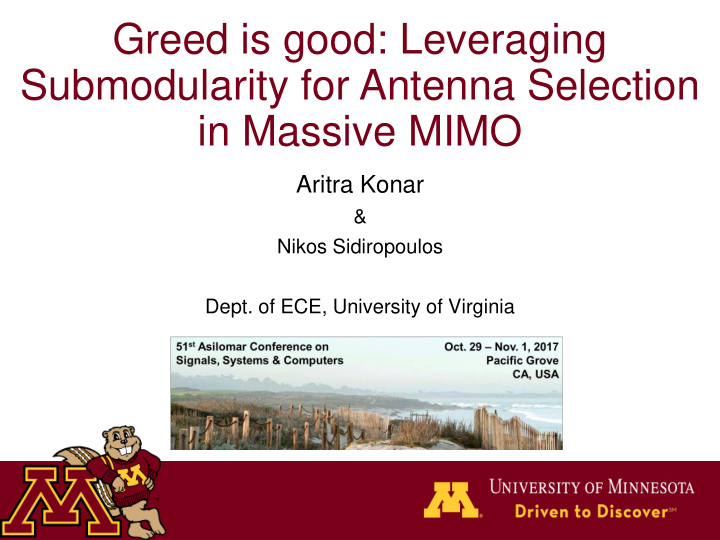



Greed is good: Leveraging Submodularity for Antenna Selection in Massive MIMO Aritra Konar & Nikos Sidiropoulos Dept. of ECE, University of Virginia
Introduction Massive MIMO: [Marzetta 2010] Large number of transmit antennas deployed at BS for serving users sharing same time-frequency resource Orders of magnitude improvement in spectral and energy efficiency Simple signal processing techniques exhibit near-optimal performance A leading physical-layer technology candidate for 5G Challenge: Cost and hardware complexity of large-scale antenna systems Assigning one RF chain per antenna element infeasible This talk: Use antenna selection to reduce the number of RF chains at BS 2
Prior Art Point-to-point case: Maximize energy efficiency [Li-Song-Debbah 2014] Heuristic selection; no theoretical guarantees Maximize received SNR [Gkizeli-Karystinos 2014] Optimally solvable in polynomial-time for receive antennas Multi-user case: Maximize downlink sum-rate capacity with fixed user power allocation [Gao et. al 2013] Convex relaxation + rounding; no theoretical guarantees Observed to work well empirically on certain measured massive MIMO channels This work: Same scenario + criterion, different algorithmic approach 3
Problem Scenario RF chain user 1 Baseband Signal Processing RF chain RF Switching Data … … Matrix … … RF chain -RF chains user K -antenna BS 4
Problem Statement Signal Model: For a given subset of antennas : received signal across all users : subset of columns of : transmit signal vector across selected antennas with : transmit power budget Antenna Selection Criterion: [Gao et. al 2013] Mixed-Integer problem, hard to solve 5
Problem Statement Problem “Simplification”: Fix user power allocations; e.g., optimal solution without selection Obtain subset selection problem NP-hard! [Ko-Lee-Queyranne 1995] Relax and Round: [Gao et. al 2013] Relax discrete variables, solve convex optimization problem, perform rounding to select antennas Computationally expensive: [M is large in massive MIMO] Hard to quantify sub-optimality of obtained solution Does there exist a more efficient and well-principled approach? 6
Submodularity Definition: A set function is submodular if for any Equivalently, for all A diminishing returns property A set function is monotone if Equivalently, for submodular functions, 7
Submodularity Proposition: Objective function of antenna selection criterion is monotone submodular Express Consider the Gaussian random vector with differential entropy (Up to additive constants) For a given subset of random variables 8
Submodularity Proof of submodularity: Differential entropy is submodular [Fujishige 1978, Kelmans-Kimelfeld 1983, Krause-Guestrin 2005, Shamaiah et al. 2010, Bach 2013] Given two arbitrary subsets Alternatively, given Proof of monotonicity: Required to show Follows as a consequence of Cauchy’s Theorem of interlacing eigen- values 9
Submodularity Antenna selection problem: Equivalent to maximizing a monotone submodular function subject to cardinality constraint on number of selected antennas The upshot: Problem is well posed Few antennas can possibly capture significant fraction of downlink capacity The catch: Still need to perform subset selection! (NP-hard) Exploit submodularity to obtain bumper-to-bumper insurance? 10
Greed is good for Antenna Selection Greedy Algorithm: Start with At iteration Guaranteed -factor approximation for all instances! [Nemhauser-Fisher-Wolsey 1978] Independent of all system parameters Provably optimal approximation factor Cannot be improved in polynomial-time [Nemhauser-Wolsey1978] 11
Greed is good for Antenna Selection Running time: Evaluate on sets Cost of evaluation Define Then Overall complexity: Can be improved to: Evaluating requires rank-1 updates of the form Can be improved further via lazy evaluations [Minoux 1978] Scales linearly with in practice 12
Preliminary Results BS with 20 antennas, 3 users, single sub-carrier, Rayleigh fading, 500 MC trials, Average approximation quality of obtained solutions (in %) Worst-case approximation quality of obtained solutions (in %) Greedy algorithm provides near-optimal solution in all cases 13
Experimental Setup: Channel Model BS equipped with ULA with following channel model AoD Path loss Setup After selection, design zero-forcing beamformer (ZFB) for reduced MIMO broadcast channel All results averaged across 500 MC trials 14
Results Scenario with 144 Tx antennas, 12 users, 5-15 (randomly chosen) scattering paths per user, Greedy selection + ZFB can indeed capture significant fraction of total downlink capacity using few RF chains ( 50% with 11% of active antennas ) 15
Conclusions Submodularity for Antenna Selection in Massive MIMO Greedy selection + ZFB works well at low complexity Extensions Multiple receive antennas per user Multiple sub-carriers Partially connected switching architectures Paves the way for significant reduction of hardware complexity in large-scale antenna systems 16
Greed is good for Antenna Selection Extensions: Multiple receive antennas per user Straightforward; -approximation factor Multiple sub-carriers Monotonicity and submodularity preserved under non-negative sums; -approximation factor Partially connected switching architectures Define array partition into disjoint sub-arrays; allocate RF chains per sub-array Feasible selection sets: 0.5-approximation factor [Fisher-Nemhauser-Wolsey 1978] 17
Sneak peek……… N = 32 RF chains in a PC RF switching network with B = 32 sub-arrays of equal size, L = 32 sub-carriers, K = 12 users with 2 receive antennas, Greedy with lazy evaluations demonstrates significantly better performance-complexity trade- off compared to convex relaxation; ZFB can still attain a significant portion of the sum-rate 18
Recommend
More recommend